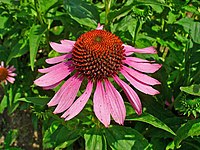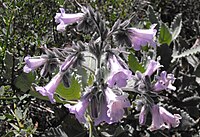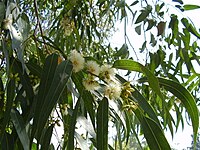E
| Scientific name | Name | Description | Picture |
|---|---|---|---|
| Echinacea purpurea | Purple coneflower | This plant and other species of Echinacea have been used for at least 400 years by Native Americans to treat infections and wounds, and as a general "cure-all" (panacea). It is currently used for symptoms associated with cold and flu | 
|
| Equisetum arvense | Horsetail | Dates back to ancient Roman and Greek medicine, when it was used to stop bleeding, heal ulcers and wounds, and treat tuberculosis and kidney problems. | 
|
| Eriodictyon crassifolium | Yerba Santa | Used by the Chumash people to keep airways open for proper breathing. The US Forest Service profile for Eriodictyon crassifolium provides information on species distribution; taxonomic relationships; ecological and evolutionary considerations for restoration; growth form and distinguishing traits; habitat characteristics; projected future suitable habitat; growth, reproduction and dispersal; biological interactions; ecological genetics; seed characteristics, germination requirements and processing; and plant uses including agriculture, restoration, and traditional products, plus an extensive bibliography. It is part of Riverside-Corona Resource Conservation District's resource materials collection on native plant recommendations for southern California ecoregions. | 
|
| Eschscholzia californica | Californian poppy | Used as an herbal remedy: an aqueous extract of the plant has sedative and anxiolytic actions. | 
|
| Eucalyptus globulus | Eucalyptus | Leaves were widely used in traditional medicine as a febrifuge. Eucalyptus oil is commonly used in over-the-counter cough and cold medications, as well as for an analgesic. | 
|
| Euonymus atropurpureus | Wahoo | Plant is a purgative and might affect the heart. | |
| Euphorbia hirta | Asthma-plant | Used traditionally in Asia to treat bronchitic asthma and laryngeal spasm. It is used in the Philippines for dengue fever. | 
|
| Euphrasia | Eyebright | Used for eye problems, mental depression, oxygenation and radiation poisoning. | 
|
| Euterpe oleracea | Açai | Although açai berries are a longstanding food source for indigenous people of the Amazon, there is no evidence that they have historically served a medicinal, as opposed to nutritional role. In spite of their recent popularity in the United States as a dietary supplement, there is currently no evidence for their effectiveness for any health-related purpose. |
Comments
Post a Comment